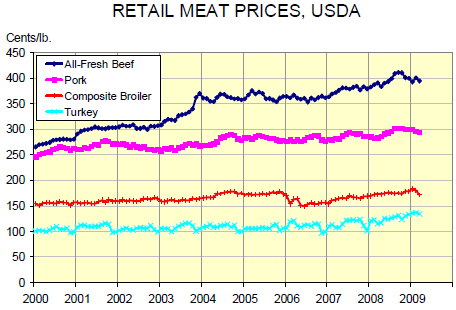



CME: Retail Price Decline for All Meat Sectors
US - CME's Daily Livestock Report for 16 April 2009.According to USDA’s monthly Meat Price Spreads, released yesterday, retail prices for all four main meat species fell in March with the decline in chicken prices being the largest of the group. The data for 1990 to date appear in the chart at left. The composite retail chicken price was estimated to be $1.716/lb, down 4.8 per cent from last month’s $1.802/lb. and 1 per cent lower than the March 2007 price of $1.732/lb.
The all-fresh beef price fell 1.5 per cent from February to $3.947/lb. That price is 1 per cent larger than last year’s March price of $3.839/lb. Retail turkey prices fell 2.2 cents/lb. (4.8 per cent) from February. March’s $1.347/lb. was 17 per cent smaller than last year’s $1.151/lb. marking the largest year-on-year increase among the four species. Retail pork prices declined 0.7 per cent in March to $2.942/lb. That is 3.8 per cent higher than one year earlier.
Note that year-on-year reductions of output had a positive impact on all of the retail prices other than chicken—whose year-on-year output reduction is the larges of the group. And chicken exports are higher this year, indicating that domestic availability is even lower than the production reductions would suggest. None of that speaks well about chicken demand, a fact that continues to raise some concerns about meat prices in 2009.
After presenting and discussing these data, we have to point out that we are not 100 per cent comfortable with them — but they are all we have at the moment. The data, which are accessible through a link here, are based on data gathered by the Bureau of Labor Statistics as part of its program to estimate the Consumer Price Index each month. Those raw data include only prices. No sales quantities are gathered. We fear this results in a systematic overstatement of retail prices since sale or feature prices usually result in higher sales quantities — or that darn sure ought to! Computing an arithmetic average, as USDA does with the BLS data, counts the everyday price and the feature price as equals when the feature prices should be weighted heavier.
We said “at the moment” above because Congress authorized another retail meat price system in the Livestock Mandatory Reporting Act of 1999. That system utilizes scanner-based data that includes FAR more cuts in each species and sales quantities for each price which allow proper sales weightings. The prices from this system are much more variable than are the BLS-based prices. They are also generally lower though year-to-year moves are often similar. You can see comparisons of the price series at the Livestock Marketing Information Center’s website. Just click Retail Meat Prices at the top of the screen.
So why aren’t these data used? Because the most recent data we have is for April 2008. USDA’s Economic Research Service stopped gathering the data when the LMRA lapsed in 2006. They went back and gathered the missed data early last year after LMRA was reauthorized but got only as far as April ‘08. It appears they have now decided there are better things to do with the funding that Congress provided for this project and have refused to update the data since that time even though it appears that the law and all of its provisions are still in effect.









